

Compact Muon Solenoid
LHC, CERN
| CMS-PAS-HIN-18-004 | ||
| Charged-particle nuclear modification factors in XeXe collisions at ${\sqrt {\smash [b]{s_{_{\mathrm {NN}}}}}}= $ 5.44 TeV | ||
| CMS Collaboration | ||
| May 2018 | ||
| Abstract: The differential yields of charged particles having pseudorapidity within $|\eta| < $ 1 are measured using 3.42 $\mu$b$^{-1}$ of XeXe collisions at ${\sqrt {\smash [b]{s_{_{\mathrm {NN}}}}}}= $ 5.44 TeV collected in 2017 by the CMS experiment at the LHC. The yields are reported as functions of collision centrality and transverse momentum, $p_{\mathrm{T}}$, from 0.5 to 100 GeV. A previously reported $p_{\mathrm{T}}$ spectrum from pp collisions at $\sqrt{s}= $ 5.02 TeV is extrapolated in center-of-mass energy to form a suitable reference for comparison. The nuclear modification factors, $R^{*}_{\mathrm{AA}}$, are constructed with this extrapolated reference and compared to previous measurements and theoretical predictions. In head-on collisions the $R^{*}_{\mathrm{AA}}$ is suppressed by a factor of six in the $p_{\mathrm{T}}$ range of 6-9 GeV but increases to approximately 0.7 at 100 GeV. A ratio between the XeXe spectra and previously reported spectra from PbPb collisions at ${\sqrt {\smash [b]{s_{_{\mathrm {NN}}}}}}= $ 5.02 TeV indicates a notably smaller suppression of charged-particle production for the same centrality selection and $p_{\mathrm{T}} > $ 6 GeV. However, the suppression in XeXe events is slightly greater than in PbPb collisions when comparing selections having a similar number of participating nucleons. | ||
|
Links:
CDS record (PDF) ;
inSPIRE record ;
CADI line (restricted) ;
These preliminary results are superseded in this paper, JHEP 10 (2018) 138. The superseded preliminary plots can be found here. |
||
| Figures & Tables | Summary | Additional Figures | References | CMS Publications |
|---|
| Figures | |

png pdf |
Figure 1:
The XeXe tracking efficiency for six centrality selections. The tracking efficiency at low-$ {p_{\mathrm {T}}} $ values decreases because of the strict track quality requirements used. Above 3 GeV the efficiency is rather flat around 73%. The shaded bands show statistical uncertainties. |

png pdf |
Figure 2:
The ratio of charged-particle spectra in pp collisions at 5.44 and 5.02 TeV for three different MC generators. A fit to the PYTHIA 8 is shown by the red line. |

png pdf |
Figure 3:
(Top panel) The charged-particle $ {p_{\mathrm {T}}} $ spectra in six classes of XeXe centrality and the pp reference spectrum after being extrapolated to $ {\sqrt {s}} = $ 5.44 TeV. The statistical uncertainties are smaller than the markers for many of the points. To facilitate direct comparison, the pp points are converted to per-event yields using a constant factor of 70 mb. (Bottom panel) The systematic uncertainties for central and peripheral XeXe collisions, as well as the pp reference. |

png pdf |
Figure 4:
The charged-particle ${R^{*}_{\text {AA}}}$ for XeXe collisions at $ {\sqrt {\smash [b]{s_{_{\mathrm {NN}}}}}} = $ 5.44 TeV in six centrality ranges. A previous measurement of ${R_{\text {AA}}}$ in PbPb collisions at $ {\sqrt {\smash [b]{s_{_{\mathrm {NN}}}}}} = $ 5.02 TeV is also shown [16]. The solid pink and open blue boxes represent the systematic uncertainties of the XeXe and PbPb data, respectively. |

png pdf |
Figure 4-a:
The charged-particle ${R^{*}_{\text {AA}}}$ for XeXe collisions at $ {\sqrt {\smash [b]{s_{_{\mathrm {NN}}}}}} = $ 5.44 TeV in 0-5% centrality range. A previous measurement of ${R_{\text {AA}}}$ in PbPb collisions at $ {\sqrt {\smash [b]{s_{_{\mathrm {NN}}}}}} = $ 5.02 TeV is also shown [16]. The solid pink and open blue boxes represent the systematic uncertainties of the XeXe and PbPb data, respectively. |
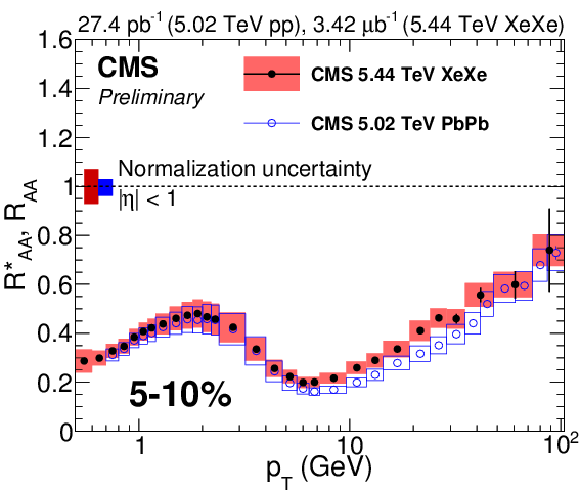
png pdf |
Figure 4-b:
The charged-particle ${R^{*}_{\text {AA}}}$ for XeXe collisions at $ {\sqrt {\smash [b]{s_{_{\mathrm {NN}}}}}} = $ 5.44 TeV in 5-10% centrality range. A previous measurement of ${R_{\text {AA}}}$ in PbPb collisions at $ {\sqrt {\smash [b]{s_{_{\mathrm {NN}}}}}} = $ 5.02 TeV is also shown [16]. The solid pink and open blue boxes represent the systematic uncertainties of the XeXe and PbPb data, respectively. |

png pdf |
Figure 4-c:
The charged-particle ${R^{*}_{\text {AA}}}$ for XeXe collisions at $ {\sqrt {\smash [b]{s_{_{\mathrm {NN}}}}}} = $ 5.44 TeV in 10-30% centrality range. A previous measurement of ${R_{\text {AA}}}$ in PbPb collisions at $ {\sqrt {\smash [b]{s_{_{\mathrm {NN}}}}}} = $ 5.02 TeV is also shown [16]. The solid pink and open blue boxes represent the systematic uncertainties of the XeXe and PbPb data, respectively. |
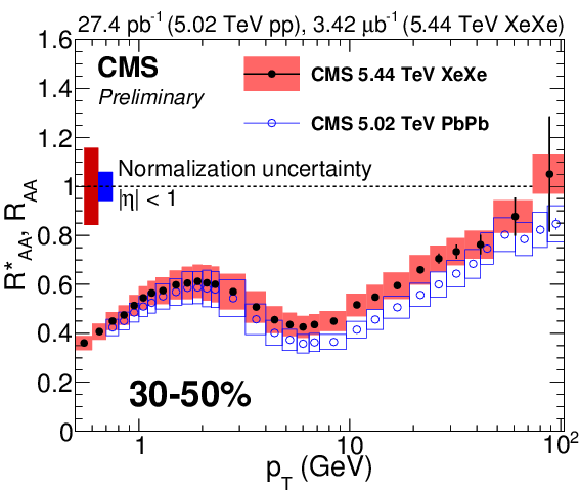
png pdf |
Figure 4-d:
The charged-particle ${R^{*}_{\text {AA}}}$ for XeXe collisions at $ {\sqrt {\smash [b]{s_{_{\mathrm {NN}}}}}} = $ 5.44 TeV in 30-50% centrality range. A previous measurement of ${R_{\text {AA}}}$ in PbPb collisions at $ {\sqrt {\smash [b]{s_{_{\mathrm {NN}}}}}} = $ 5.02 TeV is also shown [16]. The solid pink and open blue boxes represent the systematic uncertainties of the XeXe and PbPb data, respectively. |

png pdf |
Figure 4-e:
The charged-particle ${R^{*}_{\text {AA}}}$ for XeXe collisions at $ {\sqrt {\smash [b]{s_{_{\mathrm {NN}}}}}} = $ 5.44 TeV in 50-70% centrality range. A previous measurement of ${R_{\text {AA}}}$ in PbPb collisions at $ {\sqrt {\smash [b]{s_{_{\mathrm {NN}}}}}} = $ 5.02 TeV is also shown [16]. The solid pink and open blue boxes represent the systematic uncertainties of the XeXe and PbPb data, respectively. |

png pdf |
Figure 4-f:
The charged-particle ${R^{*}_{\text {AA}}}$ for XeXe collisions at $ {\sqrt {\smash [b]{s_{_{\mathrm {NN}}}}}} = $ 5.44 TeV in 70-80% centrality range. A previous measurement of ${R_{\text {AA}}}$ in PbPb collisions at $ {\sqrt {\smash [b]{s_{_{\mathrm {NN}}}}}} = $ 5.02 TeV is also shown [16]. The solid pink and open blue boxes represent the systematic uncertainties of the XeXe and PbPb data, respectively. |

png pdf |
Figure 5:
The measurement of ${R_{\text {Pb}}^{\text {Xe}}}$ in five centrality classes using the results of this analysis and data from Ref. [16]. The blue line represents the expected deviation from unity caused by the different center-of-mass energies of the two collision systems. The solid pink boxes represent the systematic uncertainties. |

png pdf |
Figure 5-a:
The measurement of ${R_{\text {Pb}}^{\text {Xe}}}$ in 0-5% centrality class using the results of this analysis and data from Ref. [16]. The blue line represents the expected deviation from unity caused by the different center-of-mass energies of the two collision systems. The solid pink boxes represent the systematic uncertainties. |

png pdf |
Figure 5-b:
The measurement of ${R_{\text {Pb}}^{\text {Xe}}}$ in 5-10% centrality class using the results of this analysis and data from Ref. [16]. The blue line represents the expected deviation from unity caused by the different center-of-mass energies of the two collision systems. The solid pink boxes represent the systematic uncertainties. |

png pdf |
Figure 5-c:
The measurement of ${R_{\text {Pb}}^{\text {Xe}}}$ in 10-30% centrality class using the results of this analysis and data from Ref. [16]. The blue line represents the expected deviation from unity caused by the different center-of-mass energies of the two collision systems. The solid pink boxes represent the systematic uncertainties. |

png pdf |
Figure 5-d:
The measurement of ${R_{\text {Pb}}^{\text {Xe}}}$ in 30-50% centrality class using the results of this analysis and data from Ref. [16]. The blue line represents the expected deviation from unity caused by the different center-of-mass energies of the two collision systems. The solid pink boxes represent the systematic uncertainties. |

png pdf |
Figure 5-e:
The measurement of ${R_{\text {Pb}}^{\text {Xe}}}$ in 50-70% centrality class using the results of this analysis and data from Ref. [16]. The blue line represents the expected deviation from unity caused by the different center-of-mass energies of the two collision systems. The solid pink boxes represent the systematic uncertainties. |

png pdf |
Figure 6:
The charged-particle ${R^{*}_{\text {AA}}}$ for XeXe collisions at $ {\sqrt {\smash [b]{s_{_{\mathrm {NN}}}}}} = $ 5.44 TeV and ${R_{\text {AA}}}$ for PbPb collisions at $ {\sqrt {\smash [b]{s_{_{\mathrm {NN}}}}}} = $ 5.02 TeV, as a function of $< N_{\text {part}} > $. The solid pink and open blue boxes represent the total systematic uncertainties in the XeXe and PbPb data, respectively. |
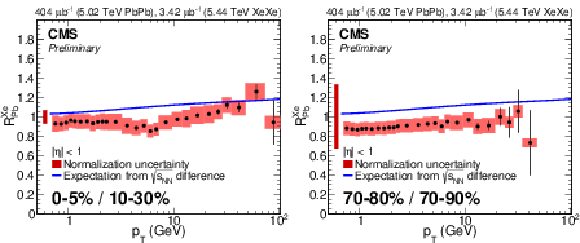
png pdf |
Figure 7:
Measurements of ${R_{\text {Pb}}^{\text {Xe}}}$ comparing centrality ranges having similar values of $< N_{\text {part}}> $. The blue line represents the expected deviation from unity caused by the different center-of-mass energies of the two collision systems. The solid pink boxes represent the systematic uncertainties. |
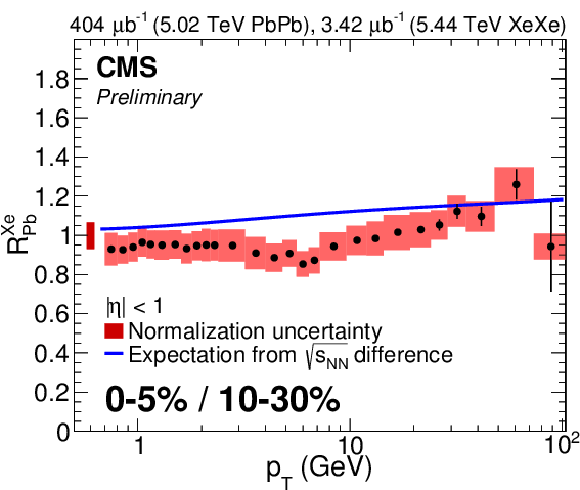
png pdf |
Figure 7-a:
Measurement of ${R_{\text {Pb}}^{\text {Xe}}}$ comparing centrality ranges having similar values of $< N_{\text {part}}> $, 0-5% and 1-30%. The blue line represents the expected deviation from unity caused by the different center-of-mass energies of the two collision systems. The solid pink boxes represent the systematic uncertainties. |

png pdf |
Figure 7-b:
Measurement of ${R_{\text {Pb}}^{\text {Xe}}}$ comparing centrality ranges having similar values of $< N_{\text {part}}> $, 70-80% and 70-90%. The blue line represents the expected deviation from unity caused by the different center-of-mass energies of the two collision systems. The solid pink boxes represent the systematic uncertainties. |

png pdf |
Figure 8:
A comparison of the charged-particle ${R^{*}_{\text {AA}}}$ for XeXe collisions at $ {\sqrt {\smash [b]{s_{_{\mathrm {NN}}}}}} = $ 5.44 TeV with theoretical predictions from Refs. [40,41,47,48,45,44,46,42,43] for 0-10% (left) and 30-50% (right) centrality classes. The hollow black boxes represent the systematic uncertainties of the XeXe data. Ratios are shown in the bottom panels, where the gray band represents the total uncertainty in the measurement. |

png pdf |
Figure 8-a:
A comparison of the charged-particle ${R^{*}_{\text {AA}}}$ for XeXe collisions at $ {\sqrt {\smash [b]{s_{_{\mathrm {NN}}}}}} = $ 5.44 TeV with theoretical predictions from Refs. [40,41,47,48,45,44,46,42,43] for 0-10% centrality class. The hollow black boxes represent the systematic uncertainties of the XeXe data. Ratios are shown in the bottom panels, where the gray band represents the total uncertainty in the measurement. |

png pdf |
Figure 8-b:
A comparison of the charged-particle ${R^{*}_{\text {AA}}}$ for XeXe collisions at $ {\sqrt {\smash [b]{s_{_{\mathrm {NN}}}}}} = $ 5.44 TeV with theoretical predictions from Refs. [40,41,47,48,45,44,46,42,43] for 30-50% centrality class. The hollow black boxes represent the systematic uncertainties of the XeXe data. Ratios are shown in the bottom panels, where the gray band represents the total uncertainty in the measurement. |
| Tables | |
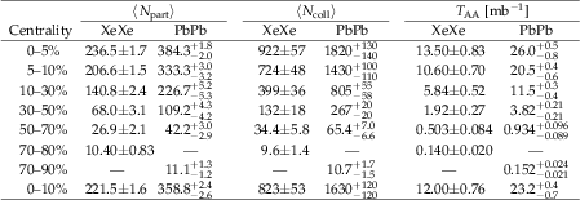
png pdf |
Table 1:
The values of $< N_{\text {part}} > $, $< N_{\text {coll}} > $, $T_{\text {AA}}$, and their uncertainties, for ${\sqrt {\smash [b]{s_{_{\mathrm {NN}}}}}} =$ 5.44 TeV XeXe collisions and ${\sqrt {\smash [b]{s_{_{\mathrm {NN}}}}}} = $ 5.02 TeV PbPb collisions in the centrality ranges used here. |
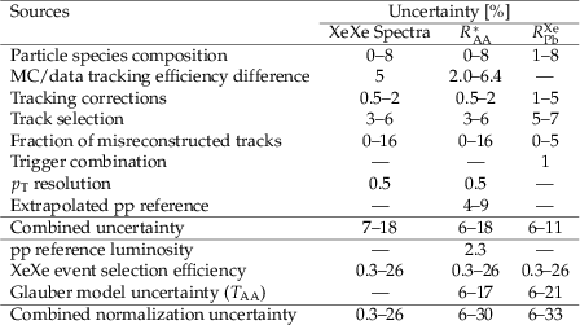
png pdf |
Table 2:
The systematic uncertainties related to the measurements reported here. The values quoted cover the centrality and $ {p_{\mathrm {T}}} $ dependence of each uncertainty. They are separated into normalization uncertainties and all other systematic uncertainties. |
| Summary |
| The transverse momentum, $ {p_{\mathrm{T}}} $, spectra of charged particles having pseudorapidity $ | {\eta} | < 1$ have been measured in several ranges of collision centrality for XeXe collisions at a center-of-mass energy per nucleon pair of 5.44 TeV. A pp reference spectrum for the same energy has been extrapolated from an existing measurement at ${\sqrt{s}} = $ 5.02 TeV using a scaling function calculated from simulated events. The nuclear modification factor with extrapolated reference, $ {R^{*}_{\text{AA}}} $, has been constructed from these spectra. In central events it is found to be suppressed by a factor of approximately 6 in the $ {p_{\mathrm{T}}} $ range of 6-9 GeV, before increasing to a value of around 0.7 at 100 GeV. This suppression is less than what has been observed in central PbPb collisions at a center-of-mass energy per nucleon pair of 5.02 TeV. A ratio of the charged-particle spectra in these two collision systems indicates this can not be completely attributed to the difference in collision energy. Charged particle production in XeXe collisions is found to be slightly more suppressed than in PbPb collisions that have a similar number of participating nucleons rather than similar centrality. Taken together, these observations indicate that the strength of parton energy loss depends on the collision system size. Predictions from the Djordjevic, scet$_G$ and cujet3.1/cibjet models are found to agree with the measured $ {R^{*}_{\text{AA}}} $. A model of Andres et al. lies on the upper edge of $ {R^{*}_{\text{AA}}} $ for central events. Finally, calculation using a linear Boltzmann transport model also agrees with the data well, except for the kinematic range 20 $ < {p_{\mathrm{T}}} < $ 60 GeV in central events, where it follows the upper edge of the data. These measurements confirm the creation of a hot medium in XeXe collisions and constrain the system size dependence of hot nuclear medium effects. |
| Additional Figures | |

png pdf |
Additional Figure 1:
The charged-particle $R^{*}_{\mathrm {AA}}$ for XeXe collisions at $ {\sqrt {\smash [b]{s_{_{\mathrm {NN}}}}}} = $ 5.44 TeV in the 0-80% centrality range. The asterisk on $R^{*}_{\mathrm {AA}}$ indicates the use of a pp reference extrapolated in center-of-mass energy from 5.02 to 5.44 TeV. A previous measurement of $R_{\mathrm {AA}}$ in inclusive PbPb collisions at $ {\sqrt {\smash [b]{s_{_{\mathrm {NN}}}}}} = $ 5.02 TeV is also shown [16]. The solid pink and open blue boxes represent the systematic uncertainties in the XeXe and PbPb data, respectively. |

png pdf |
Additional Figure 2:
The charged-particle $R^{*}_{\mathrm {AA}}$ for XeXe collisions at $ {\sqrt {\smash [b]{s_{_{\mathrm {NN}}}}}} = $ 5.44 TeV and $R_{\mathrm {AA}}$ for PbPb collisions at $ {\sqrt {\smash [b]{s_{_{\mathrm {NN}}}}}} = $ 5.02 TeV [16], as a function of $< N_{\text {part}} > $. The asterisk on $R^{*}_{\mathrm {AA}}$ indicates the use of a pp reference extrapolated in center-of-mass energy from 5.02 to 5.44 TeV. The solid pink and open blue boxes represent the total systematic uncertainties in the XeXe and PbPb data, respectively. |

png pdf |
Additional Figure 3:
A ratio between XeXe and PbPb spectra [16] ($R^{\mathrm {Xe}}_{\mathrm {Pb}}$) comparing centrality ranges having similar values of $< N_{\text {part}}> $. The blue line represents the expected deviation from unity caused by the different center-of-mass energies of the two collision systems. The solid pink boxes represent the systematic uncertainties. |
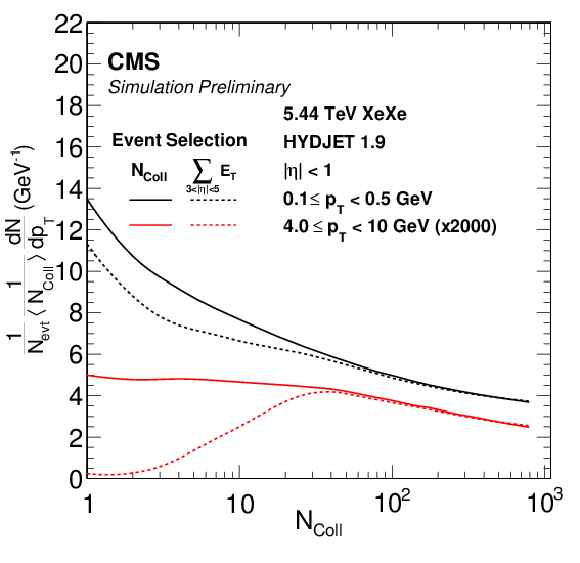
png pdf |
Additional Figure 4:
The $N_{\text {coll}}$-scaled differential yield of charged particles as a function of $N_{\text {coll}}$ for two different $p_{\text {T}}$ selections in XeXe hydjet events at 5.44 TeV. The yields are shown after selecting events based on the generator level $N_{\text {coll}}$ (solid lines), or using the total $E_{\text {T}}$ measured in the forward region (dashed lines). |

png pdf |
Additional Figure 5:
The $N_{\text {coll}}$-scaled differential yield of charged particles as a function of $N_{\text {coll}}$ for two different $p_{\text {T}}$ selections in XeXe ampt with string melting events at 5.44 TeV. The yields are shown after selecting events based on the generator level $N_{\text {coll}}$ (solid lines), or using the total $E_{\text {T}}$ measured in the forward region (dashed lines). |

png pdf |
Additional Figure 6:
The event selection bias predicted by the hydjet and ampt with string melting event generators, as a function of centrality and $p_{\text {T}}$. The bias is evaluated by taking a ratio between charged-particle differential yields selected with generator-level $N_{\text {coll}}$ and a centrality selection using the $E_{\text {T}}$ in the forward region. |
| References | ||||
| 1 | J. D. Bjorken | Energy loss of energetic partons in quark-gluon plasma: Possible extinction of high $ p_{T} $ jets in hadron-hadron collisions | FERMILAB-PUB-82-059-T, Fermilab | |
| 2 | D. d'Enterria | Jet quenching | in Relativistic Heavy Ion Physics, R. Stock, ed Landolt-B\"ornstein | 0902.2011 |
| 3 | M. Gyulassy, I. Vitev, and X. N. Wang | High $ p_{\text{T}} $ azimuthal asymmetry in noncentral A+A at RHIC | PRL 86 (2001) 2537 | nucl-th/0012092 |
| 4 | A. M. Poskanzer and S. A. Voloshin | Methods for analyzing anisotropic flow in relativistic nuclear collisions | PRC 58 (1998) 1671 | nucl-ex/9805001 |
| 5 | J.-Y. Ollitrault | Anisotropy as a signature of transverse collective flow | PRD 46 (1992) 229 | |
| 6 | P. F. Kolb, J. Sollfrank, and U. W. Heinz | Anisotropic transverse flow and the quark hadron phase transition | PRC 62 (2000) 054909 | hep-ph/0006129 |
| 7 | M. L. Miller, K. Reygers, S. J. Sanders, and P. Steinberg | Glauber modeling in high energy nuclear collisions | Ann. Rev. Nucl. Part. Sci. 57 (2007) 205 | nucl-ex/0701025 |
| 8 | BRAHMS Collaboration | Quark gluon plasma and color glass condensate at RHIC? The perspective from the BRAHMS experiment | NP A 757 (2005) 1 | nucl-ex/0410020 |
| 9 | B. B. Back et al. | The PHOBOS perspective on discoveries at RHIC | NP A 757 (2005) 28 | nucl-ex/0410022 |
| 10 | STAR Collaboration | Experimental and theoretical challenges in the search for the quark gluon plasma: The STAR Collaboration's critical assessment of the evidence from RHIC collisions | NP A 757 (2005) 102 | nucl-ex/0501009 |
| 11 | PHENIX Collaboration | Formation of dense partonic matter in relativistic nucleus-nucleus collisions at RHIC: Experimental evaluation by the PHENIX collaboration | NP A 757 (2005) 184 | nucl-ex/0410003 |
| 12 | ALICE Collaboration | Centrality dependence of charged particle production at large transverse momentum in Pb--Pb collisions at $ \sqrt{s_{\text{NN}}} = $ 2.76 TeV | PLB 720 (2013) 52 | 1208.2711 |
| 13 | ALICE Collaboration | Transverse momentum spectra and nuclear modification factors of charged particles in pp, p-Pb and Pb-Pb collisions at the LHC | Submitted | 1802.09145 |
| 14 | ATLAS Collaboration | Measurement of charged-particle spectra in Pb+Pb collisions at $ \sqrt{s_{\text{NN}}} = $ 2.76 TeV with the ATLAS detector at the LHC | JHEP 09 (2015) 050 | 1504.04337 |
| 15 | CMS Collaboration | Study of high-$ p_{\text{T}} $ charged particle suppression in PbPb compared to pp collisions at $ \sqrt{s_{\text{NN}}} = $ 2.76 TeV | EPJC 72 (2012) 1945 | CMS-HIN-10-005 1202.2554 |
| 16 | CMS Collaboration | Charged-particle nuclear modification factors in PbPb and pPb collisions at $ \sqrt{s_{\text{NN}}} = $ 5.02 TeV | JHEP 04 (2017) 039 | CMS-HIN-15-015 1611.01664 |
| 17 | ATLAS Collaboration | Transverse momentum, rapidity, and centrality dependence of inclusive charged-particle production in $ \sqrt{s_{\text{NN}}}= $ 5.02 TeV p + Pb collisions measured by the ATLAS experiment | PLB 763 (2016) 313 | 1605.06436 |
| 18 | C. Loizides, J. Nagle, and P. Steinberg | Improved version of the PHOBOS Glauber Monte Carlo | SoftwareX 1-2 (2015) 13 | 1408.2549 |
| 19 | CMS Collaboration | Description and performance of track and primary-vertex reconstruction with the CMS tracker | JINST 9 (2014) P10009 | CMS-TRK-11-001 1405.6569 |
| 20 | CMS Collaboration | The CMS trigger system | JINST 12 (2017) P01020 | CMS-TRG-12-001 1609.02366 |
| 21 | CMS Collaboration | The CMS experiment at the CERN LHC | JINST 3 (2008) S08004 | CMS-00-001 |
| 22 | K. Werner, F.-M. Liu, and T. Pierog | Parton ladder splitting and the rapidity dependence of transverse momentum spectra in deuteron-gold collisions at RHIC | PRC 74 (2006) 044902 | hep-ph/0506232 |
| 23 | T. Pierog et al. | EPOS LHC: Test of collective hadronization with data measured at the CERN Large Hadron Collider | PRC 92 (2015) 034906 | 1306.0121 |
| 24 | I. P. Lokhtin and A. M. Snigirev | A model of jet quenching in ultrarelativistic heavy ion collisions and high-$ p_{T} $ hadron spectra at RHIC | EPJC 45 (2006) 211 | hep-ph/0506189 |
| 25 | T. Sjostrand, S. Mrenna, and P. Z. Skands | A brief introduction to PYTHIA 8.1 | CPC 178 (2008) 852 | 0710.3820 |
| 26 | CMS Collaboration | Event generator tunes obtained from underlying event and multiparton scattering measurements | EPJC 76 (2016) 155 | CMS-GEN-14-001 1512.00815 |
| 27 | C. Loizides, J. Kamin, and D. d'Enterria | Precision Monte Carlo Glauber predictions at present and future nuclear colliders | 1710.07098 | |
| 28 | CMS Collaboration | Particle-flow reconstruction and global event description with the CMS detector | JINST 12 (2017) P10003 | CMS-PRF-14-001 1706.04965 |
| 29 | ALICE Collaboration | Multi-strange baryon production at mid-rapidity in Pb-Pb collisions at $ \sqrt{s_{\text{NN}}} = $ 2.76 TeV | PLB 728 (2014) 216 | 1307.5543 |
| 30 | CMS Collaboration | Charged particle transverse momentum spectra in pp collisions at $ \sqrt{s} = $ 0.9 and 7 TeV | JHEP 08 (2011) 086 | CMS-QCD-10-008 1104.3547 |
| 31 | M. Bahr et al. | Herwig++ physics and manual | EPJC 58 (2008) 639 | 0803.0883 |
| 32 | C.-Y. Wong and G. Wilk | Tsallis fits to $ p_{\text{T}} $ spectra for pp collisions at LHC | Acta Phys. Polon. B 43 (2012) 2047 | 1210.3661 |
| 33 | CMS Collaboration | Nuclear effects on the transverse momentum spectra of charged particles in pPb collisions at $ \sqrt{s_{\text{NN}}} = $ 5.02 TeV | EPJC 75 (2015) 237 | CMS-HIN-12-017 1502.05387 |
| 34 | CMS Collaboration | CMS luminosity calibration for the pp reference run at $ \sqrt{s}= $ 5.02 TeV | CMS-PAS-LUM-16-001 | CMS-PAS-LUM-16-001 |
| 35 | M. Arneodo | Nuclear effects in structure functions | PR 240 (1994) 301 | |
| 36 | CMS Collaboration | Measurement of the elliptic anisotropy of charged particles produced in PbPb collisions at $ \sqrt{s_{\text{NN}}} = $ 2.76 TeV | PRC 87 (2013) 014902 | CMS-HIN-10-002 1204.1409 |
| 37 | PHENIX Collaboration | Spectra and ratios of identified particles in Au+Au and $ d $+Au collisions at $ \sqrt{s_{\text{NN}}}= $ 200 GeV | PRC 88 (2013) 024906 | 1304.3410 |
| 38 | C. Loizides and A. Morsch | Absence of jet quenching in peripheral nucleus--nucleus collisions | PLB 773 (2017) 408 | 1705.08856 |
| 39 | J. Jia | Influence of the nucleon--nucleon collision geometry on the determination of the nuclear modification factor for nucleon--nucleus and nucleus--nucleus collisions | PLB 681 (2009) 320 | 0907.4175 |
| 40 | Y. He, T. Luo, X.-N. Wang, and Y. Zhu | Linear Boltzmann transport for jet propagation in the quark-gluon plasma: Elastic processes and medium recoil | PRC 91 (2015) 054908 | 1503.03313 |
| 41 | S. Cao, T. Luo, G.-Y. Qin, and X.-N. Wang | Heavy and light flavor jet quenching at RHIC and LHC energies | PLB 777 (2018) 255 | 1703.00822 |
| 42 | M. Djordjevic | Theoretical formalism of radiative jet energy loss in a finite size dynamical QCD medium | PRC 80 (2009) 064909 | 0903.4591 |
| 43 | M. Djordjevic and M. Djordjevic | LHC jet suppression of light and heavy flavor observables | PLB 734 (2014) 286 | 1307.4098 |
| 44 | J. Xu, J. Liao, and M. Gyulassy | Bridging soft-hard transport properties of quark-gluon plasmas with CUJET3.0 | JHEP 02 (2016) 169 | 1508.00552 |
| 45 | S. Shi, J. Liao, and M. Gyulassy | Probing the color structure of the perfect QCD fluids via soft--hard--event--by--event azimuthal correlations | 1804.01915 | |
| 46 | C. Andr\'es et al. | Energy versus centrality dependence of the jet quenching parameter $ \hat{q} $ at RHIC and LHC: a new puzzle? | EPJC 76 (2016) 475 | 1606.04837 |
| 47 | Z.-B. Kang et al. | Jet quenching phenomenology from soft-collinear effective theory with Glauber gluons | PRL 114 (2015) 092002 | 1405.2612 |
| 48 | Y.-T. Chien et al. | Jet quenching from QCD evolution | PRD 93 (2016) 074030 | 1509.02936 |

|
Compact Muon Solenoid LHC, CERN |

|

|

|

|

|

|